| Secrets of Digital Photography Sharpness! |
|
Jump back to Breaking News... A point often overlooked in the digital camera field is the behavior of optics. Not lens to lens, but zone to zone within a lens. |
Digital cameras have lenses, just like every other camera. While most 35mm photographers are used to the idea of performance numbers by area of the image, the general concept of zone-by-zone sharpness variation within an optic system is not a well illuminated subject for digital photographers. Here is some help to get you through the night. A lot of recent press about the relative merits of the Nikon 990 and 995 cameras raises questions. The answers are often surprising. Q: Is the 995 lens sharper than the 990 lens? Q: Do digital camera lenses perform better at particular places in the image? Q: Do digital camera lenses perform better at particular f-stops? Q: Do digital camera lenses perform better at particular zoom settings? Q: Can a soft lens outperform a sharp lens? Q: Do images focus flat? Lenses are mass produced. All lenses are made of elements that are NOT ground specifically to mate with individual samples of corresponding optics. Each and every lens is slightly different from its same-specification replicants. So when complex lens systems are assembled, they are MATCHED to each other by sorting individual elements into tolerance priorities and combining them in sub assembly modules that are themselves prioritized and matched to other modules.
The tolerances here are microscopic and in general, a shortfall of one parameter in one module is mated to another that just happens to compensate for it. Many elements, sub assembly modules, clusters of modules and even finally assembled lenses are discarded when they don't match specifications. The lens is rotationally symmetrical. Rather like it had been designed on a lathe. The optical axis runs down the center (green line) and in theory it is precisely centered over the imager. Any element that wanders a micro-hair off center --as if its own individual optical center were slid slightly to the side-- can introduce optical phenomena that affect one corner or edge. Lens designers have goals. One is to make the entire lens as sharp as can be over the entire picture, but the magic word is "compromise". How much could you achieve if you allowed a certain tolerance in the general performance of a particular lens design? Another goal is to create a 3:1 or 4:1 zoom . When the design starts out, the first tool is the computer. It can simulate the performance of the zoom lens well enough to guide the designer through inspired refinements. Just like any creative process, sometimes the designer must back up and start over, but with the long history of designs in his or her computer, the problem-solving precedents are helpful to solve problems along the way. A perfect lens would be sharp center, edge and corner of every image. That silicon imaging chip is about a dozen times flatter, proportionally, than 35, 2-1/4 or 4x5 film is in a camera, so the target for a digital lens is exemplary. The imager in the 990 and 995 is the Sony 3.34 megapixel chip. It is built to sub-micron tolerances and as manufacturing of this device "ages" the performance of the chip gets better and the yield of good chips to underachieving chips goes up. Generally, any manufacturing line will get better, more efficient and produce a more "tweaked" product over time. Until some new variable is introduced. If Sony's engineers introduced a new idea, such as a new dye for the magenta filter, it would probably cause a hiccup in the yield for a while.
How does it perform? Any two samples will likely not perform exactly identically. This is true in all optics. Those items are strictly analog. Digital items can "behave" the same, but they do it by logic. Serial number xxxxxxx1 and xxxxxx2 will not share every single measurable characteristic. Lenses almost universally deteriorate in contrast and sharpness starting from the optical center and moving farther off-axis. The corners and edges of an image are the first to show this effect. But--and
this is a big item--most unsharpness in the corners of a frame
will quickly evaporate with f-stop. A model change is dramatic. The same issues come back in new pants. Especially when the central optic undergoes a major revision as has occurred from the Coolpix 990 to 995. Here is an image from the very upper left corner of a 995 frame showing the difference that aperture can make. The small amount of unsharpness in the corner isn't much, but if you roll your mouse over the image, you will see how it looks at wide open, f/2.6 and at optimum, f/6.0.
The middle of the image was fine and until I did the test, all I had been experiencing was wonderful pictures. It just goes to show:
What none of these samples show are the effects of different zoom settings (all are full wide), different focus settings (all were essentially at infinity) and different camera sample settings (only one of each camera model was tested). Your mileage will probably vary. On each of these cameras some corners showed different effects from others. Not even each corner behaved like its immediate kin. So the answers are: Q: Is the 995 lens sharper than the 990 lens?
Q: Do digital camera lenses perform better at particular places in the image?
Q: Do digital camera lenses perform better at particular f-stops?
Q: Do digital camera lenses perform better at particular zoom settings?
Q: Can a soft lens outperform a sharp lens?
I would hazard a guess that the recent revelations around the rather large change to the 995 zoom lens will prompt a lot of discussion and perhaps test procedures for evaluating digital cameras that more closely mirror those often applied to larger format cameras. |
|
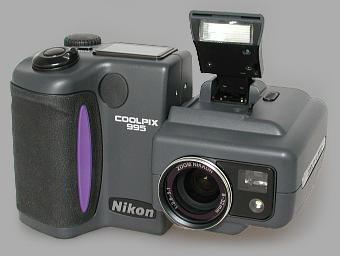 Sharpness
Challenged?
Sharpness
Challenged?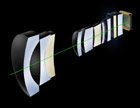 The
zoom lens in your camera looks something like this. Some elements
move, others stay stationary. Variables are always changing as
iris, zoom and focus are adjusted. Computerized tests of each
subassembly allows "best combinations" of modules to
grow right up to the final item.
The
zoom lens in your camera looks something like this. Some elements
move, others stay stationary. Variables are always changing as
iris, zoom and focus are adjusted. Computerized tests of each
subassembly allows "best combinations" of modules to
grow right up to the final item.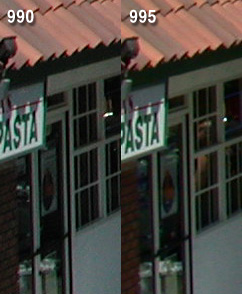
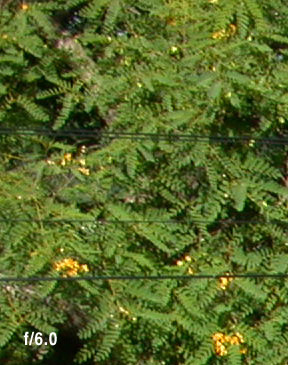

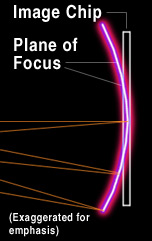 Q: Do images focus flat?
Q: Do images focus flat?